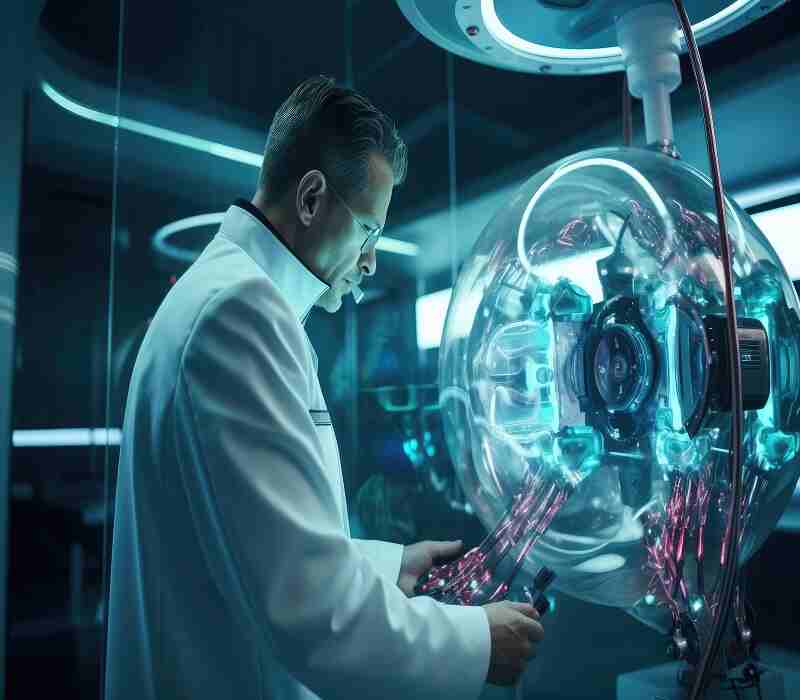Introduction to a World-Leading Research Center
Situated in Purdue University’s Discovery Park, the Birck Nanotechnology Center is among the most advanced nanotechnology research facilities in the world. The 187,000-square-foot facility opened in 2005 and has since served as a hub for groundbreaking research linking academic discovery with pragmatic application. The center was enabled through a $30 million gift from Purdue alumnus Michael Birck and his wife Katherine, a testament to their commitment to the pursuit of scientific frontiers.
What most differentiates the Birck Nanotechnology Center is that it’s an integrated center for nanotechnology research. All but one other center is dedicated to a particular facet of nanoscience, while Birck houses materials synthesis, device fabrication, characterization, and modeling under a single facility. This means scientists can bring an idea into conception through the stages of prototype design without ever needing to exit the center.
The importance of the center extends far beyond academic circles. With the world increasingly dependent on technology today, nanotechnology has moved into the spotlight for advances in computing, medicine, energy, and national defense. The Birck Nanotechnology Center plays a critical role in such advancements, as a research hub and training ground for the nanoscientists and engineers of the future.
State-of-the-Art Facilities and Capabilities
The Cleanroom: A Marvel of Precision Engineering
The heart of the Birck Nanotechnology Center is its crown jewel – a 25,000-square-foot cleanroom that ranks among the country’s largest and most sophisticated academic cleanrooms. This state-of-the-art facility has ISO Class 3 (Class 1) conditions in critical environments, meaning there are fewer than 1,000 particles (0.1 microns or larger) per cubic meter of air. In order to achieve this high level of hygiene, the cleanroom also has a cutting-edge air filter system that replaces the air completely every six seconds.
The cleanroom is also divided into specialty bays, where various nanofabrication processes are conducted. The lithography bay, for instance, contains electron beam lithography tools that can create features as thin as 8 nanometers – about 10,000 times thinner than a human hair. Nearby, the deposition bay contains several physical and chemical vapor deposition systems utilized to grow thin films at the atomic level.
What actually sets Birck’s cleanroom apart is its cutting-edge “open access” policy. Unlike most other comparable labs, which restrict equipment use to specially skilled professionals, Birck trains graduate students as well as qualified undergrads to operate advanced tools following extensive training courses. Such a philosophy has proved very much worthwhile in training future generation specialists in nanotechnology.
Advanced Characterization Suite: Looking Beyond the Visible
To support its fabrication capability, the Birck Nanotechnology Center has an impressive arsenal of characterization equipment that allows scientists to examine materials at the atomic level. The microscopy suite at the center houses several transmission electron microscopes (TEMs) with sub-angstrom resolution, which allows scientists to observe individual atoms in materials.
One such exemplary instrument is the aberration-corrected scanning transmission electron microscope (STEM), which not only images atoms, but can identify them chemically through electron energy loss spectroscopy. Such capability has been instrumental in designing new materials for semiconductors for the next generation of electronics.
A number of specialty microscopy systems are also resident in the center:
Atomic force microscopes (AFMs) with advanced features like Kelvin probe force microscopy to measure electrical nanoscale properties
Confocal Raman microscopes that combine chemical analysis with high spatial resolution
Cryogenic electron microscopes for the study of biological nanostructures at low temperatures
These technologies combined provide researchers with an unprecedented ability to understand and control matter at its most basic scales.
Research Thrusts and Breakthrough Innovations
Semiconductor Research and Quantum Technologies
The Birck Nanotechnology Center is now a global leader in semiconductor research, with a focus on the development of wide-bandgap semiconductors like gallium nitride (GaN) and silicon carbide (SiC). The materials are revolutionizing power electronics through more efficient, compact, and high-temperature operating devices compared to traditional silicon-based devices.
One of the first projects is the development of vertical GaN transistors for automotive electric vehicle power systems. Leveraging the center’s unique synergy of material growth and nanofabrication capabilities, researchers at Purdue have developed transistors that can potentially revolutionize the range and performance of electric vehicles and reduce charging time.
In the area of quantum technologies, Birck researchers are making progress in several areas:
Developing quantum dots for quantum computing usage
Designing topological insulators for long-term quantum information storage
Synthesizing new superconducting materials for quantum sensing devices
The two-dimensional nanoscale systems under study at the center are particularly enhanced by the ability of the facility to both synthesize materials and make devices within the same facility, avoiding concerns about contamination and allowing rapid redesign cycles.
Biomedical Nanotechnology: From Diagnostics to Therapeutics
The intersection of medicine and nanotechnology is one of the most exciting fields of study at the Birck Nanotechnology Center. Researchers are developing new solutions from cutting-edge diagnostic tools to targeted therapeutic delivery systems.
A research group led by Dr. Jacqueline Linnes created a new paper-based diagnostic platform that can detect several disease biomarkers simultaneously. The technology, which was developed in Birck’s cleanroom, uses nanostructured paper to create low-cost, handheld tests that could revolutionize healthcare for the poor and resource-poor settings.
In the field of therapy, researchers are creating nanoparticles for drug delivery. One of the most promising research initiatives is with gold nanoparticles that will deliver cancer drugs directly to tumors and restrict side effects. These nanoparticles are being functionalized with targeting molecules in Birck’s bio-nanotechnology laboratories.
Energy and Environmental Applications
Conquering the challenges of global energy is one of the Birck Nanotechnology Center’s highest priorities. Researchers are attacking the problem on many fronts as they work to develop more efficient solar cells, advanced battery technologies, and novel catalysts for clean fuel production.
The center’s research on perovskite solar cells has been of significant interest. By employing nanoscale engineering techniques, researchers have improved the efficiency and stability of these promising photovoltaic materials. Recent developments have witnessed the demonstration of perovskite solar cells with efficiencies above 25% – achieving the same level of performance as traditional silicon cells but perhaps at much reduced manufacturing costs.
In energy storage, Birck researchers are exploring nanomaterials for next-generation batteries. One effort is targeting silicon nanowire anodes with the potential to significantly boost the energy density of lithium-ion batteries. Another is designing solid-state batteries with nanostructured electrolytes for improved safety and performance.
Educational Impact and Workforce Development
Aside from its research role, the Birck Nanotechnology Center is also a vital center for training future scientists and engineers. The center offers advanced training programs to prepare students for careers in nanotechnology and other fields.
The center’s educational activities are:
A semester course on nanotechnology lab where students get hands-on experience of cleanroom fabrication and characterization techniques
Summer research experience for undergraduate students at Purdue and other institutions
Professional training workshops for industry scientists
Outreach initiatives that introduce K-12 students to the principles of nanotechnology
These efforts have been surprisingly successful, with many pursuing careers at leading semiconductor companies, national laboratories, and research institutions. The alumni network of the center now includes hundreds of professionals on the leading edge of nanotechnology development globally.
Industry Collaboration and Technology Transfer
Birck Nanotechnology Center has intense industry partnerships with industry leaders with whom it does joint research and transfers technology. The center hosts major firms’ research programs including Intel, Texas Instruments, and Analog Devices by utilizing its resources and those of researchers at Purdue.
One success story is that of a startup firm generated from Birck research. The firm, initiated by a Purdue professor and his students, invented a novel nanofabrication technique for the production of high-performance sensors. The technology was created first in Birck’s cleanroom and was licensed and now is used in industrial monitoring systems worldwide.
The center’s technology transfer office is also doing its best to protect intellectual property and facilitate commercialization of research results. In recent years, Birck innovations have led to:
Over 50 patent filings
15 licensed technologies
5 startup companies
A number of industry partnerships
This record indicates the center’s commitment to translating basic research into useful applications that serve society.
Future Directions and Expanding Horizons
As nanotechnology continues to evolve, the Birck Nanotechnology Center is working hard to drive the boundaries of emerging fields of research. Current plans for expansion are focused in some key areas:
Advanced Packaging and Heterogeneous Integration
Since the semiconductor industry is approaching physical limits of shrinking transistors, new ways of system integration are becoming imperative. Birck researchers are working on 3D integration techniques that stack different kinds of chips vertically, enabling performance to keep on improving. The center is making investments in wafer bonding equipment, through-silicon via formation equipment, and high-precision alignment equipment to enable this important work.
Bio-Nano Interfaces
The intersection of biological systems and nanotechnology is an emerging research activity. Researchers are developing novel platforms for investigating and engineering interactions of living systems and nanomaterials at Birck. These applications are targeted drug delivery, biosensing, and neural interfaces.
AI-Enabled Nanofabrication
The institute is also bringing machine learning and artificial intelligence into its research efforts. One of the exciting projects uses AI to optimize nanofabrication processes in real time, potentially revolutionizing how we create nanoscale devices. Another project uses machine learning to analyze vast amounts of microscopy data, accelerating material discovery.
Conclusion: A Catalyst for Nanotechnology Innovation
The Birck Nanotechnology Center is a monument to what visionary philanthropy, academic achievement, and state-of-the-art facilities can accomplish. Since its operation began nearly two decades ago, the center has become one of the world’s leading nanotechnology research centers, playing a part in breakthroughs that range from basic science to products on the commercial market.
It is Birck’s unique ecosystem of great researchers, leading-edge equipment, and open atmosphere that differentiates it. It encourages innovation in every stage, from the undergraduate students carrying out their initial experiments to senior professors cracking large scientific problems.
As nanotechnology continues to transform industries and improve lives, the Birck Nanotechnology Center will definitely be at the forefront of this revolution. With its ongoing research in semiconductors, quantum technologies, biomedical research, and energy solutions, it promises to deliver innovations that will define the future of technology. For researchers, students, and industry partners alike, the center offers unparalleled opportunities to be a part of this exciting journey of innovation and discovery.



